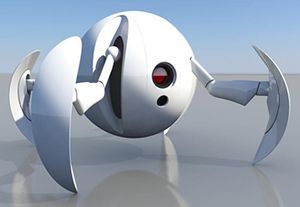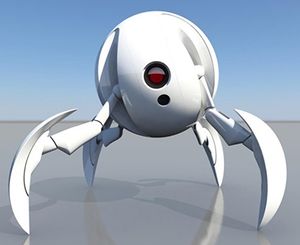There are multiple variants of this technology, please refer to Drone Disambiguation for a list of the variants. |


The Automated Support Robot or A.S.R. (colloquially called a Drone) is designed as a multipurpose robot with the ability to move via its 4 retractable legs on a variety of surfaces or via a generated antigravity field. The four 'legs' of the device contain a variety of tools and scanning equipment. A Drone is primarily an engineering device, though specialized versions can perform other tasks.
Drones use a multioptic eye-like sensor to 'see' in the full EM spectrum from low power radio emissions all the way up into the gamma ray range. Below the singular eye is a combination holographic imaging transceiver and spacial sensing array. Drones use these two primary sensors to bring in a large range of information from the world around them.
Dimensions
- Sphere Diameter
- Half a Meter
Range
- Command & Control
- 1 Light Year
- Travel Before Refueling
- 10 km, 50 km with high capacity batteries installed
- Average Travel / Usage before Refueling
- ~ 5km and 72 hours of use
Operation
A Drone contains a basic AI system allowing it to be loaded with various protocols that it then can execute and even modify to some extent to suit specific situations. Commonly these are engineering protocols, when aboard a ship, station, or within communication range of a larger computer system. A Drone is fully capable of maintaining most technological systems given it has an ample supple of power, more than one Drone (to conduct repairs on Drones themselves), and a transporter / matter replication system. This maintenance mode can be maintained for prolonged periods of time, though theoretically it is likely that given enough time simultaneous failure of enough Drones and equipment would make it impossible to autonomously continue to support a complex system like a vessel or base.
Specialized
Specialty Drones can also be used for surveillance, defense, and offense. Outfitted with shields, weapons, or extended sensing gear the Drone can be a platform for assisting in in tactical, rescue, and training maneuvers. These Drones can optionally be outfitted with a single Warp Field Coil allowing low warp speed jumps.
Power Source
Drones are powered by a micro fusion reactor at their core combined with high capacity batteries. They can also seek out sources of deuterium to refuel from.
A Note on Intelligence / Personality
There is no particular personality built into the drones, nor do they have the capacity to be self-aware or otherwise sentient. They do, however, have the capacity to develop personal reactions to stimulus. They do learn and can be programmed with knowledge. Thus through interaction they can develop behavior that is personality-like though they have no mind per-se. A drone could be taught to communicate via blinking to confirm or deny a question (yes or no) but they have no verbal skills nor are they capable of textual conversations via a computer interface. A drone could also be taught to make noises, simulating whistling or bleeping / beeping in a particular tone or pattern on request. As such one might compare their interpersonal interactions as having a kind of virtual pet. This is rare, as most of the time they are completely computer controlled and have little interaction with people. They are not alive though they have intelligence and learning capabilities but cannot be taught to be sentient more than a small animal might be considered intelligent / self aware.